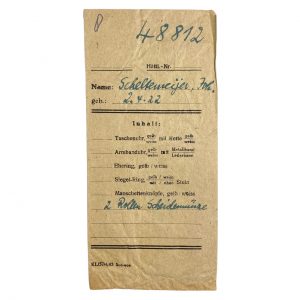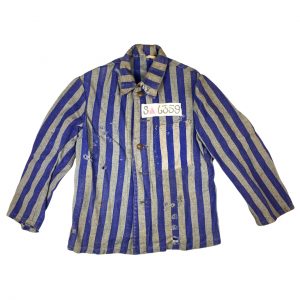Neuengamme – Personal effect bag of Aart van Triest
This personal effect bag belonged to the Dutchman Aart van Triest.
Aart van Triest, born on August 12, 1921 in Utrecht, worked as a police officer in Amsterdam during World War II.
During his work he also became active for the resistance in Amsterdam.
He was arrested on September 13, 1944 and taken to Camp Amersfoort. On October 11, 1944, he and about 1,400 other prisoners were deported by train to Neuengamme concentration camp.
Not only were resistance fighters on this transport, but also the men of the Razzia van Putten.
Aart van Triest arrived in Neuengamme on 14 October 1944 and upon arrival the men were shaved bald and given a new camp number. (56154)
On arrival at Neuengamme concentration camp, the prisoners had to put their valuables in this paper bag and it was kept in the ‘Effektenkammer’.
The living conditions in Neuengamme were extremely bad and Aart van Triest died on March 16, 1945. The bag states that Aart van Triest was in possession of 1 silver coin and this was kept during his captivity.
Neuengamme
Concentration Camp Neuengamme was inaugurated on December 13, 1938 and was located about 18 kilometers from the German city of Hamburg.
Neuengamme was an annex of the well-known concentration camp Sachsenhausen, but from June 1940 it became an independent concentration camp.
During World War II, some 106,000 inmates stayed in the camp, 42,900 of whom died due to poor living conditions, lack of food, disease and forced labour. Resistance fighters, Jews, homosexuals, gypsies, hostages and Jehovah’s Witnesses were imprisoned in the camp.
All personal belongings had to be handed in on arrival.
Then all body hair was shaved off and a striped camp uniform with a new prisoner number was given.
Neuengamme had three commanders during the war, SS-Sturmbahnführer Walter Eisfeld (1940), SS-Obersturmbahnführer Martin Weiß (1940 – 1942) and SS-Standartenführer Max Pauly (1942 – 1945).
During the entire war, about 4,500 guards worked at the Neuengamme concentration camp.
From April 20, thousands of Neuengamme prisoners were loaded onto ships, including the Cap Arcona and the Thielbek, and left in the Bay of Lübeck.
In this way, the Nazis tried to cover up the evidence that the concentration camp had existed.
Mistaking the ships for troop transporters, the Allies sank the ships on May 3, 1945, killing an estimated 7,500 people.
Many who managed to reach the shore were shot by the SS. The SS had deliberately left about 600 prisoners to dismantle the Neuengamme concentration camp and destroy the administration.
On May 4, 1945, Neuengamme was liberated by the British and they found an empty camp.







